Am brand new to the game and after seeing YG hit dice shown on Youtube was hoping someone would know if they will be produced again or if anyone would like to sell a set.
Mussolini's War series
-
Hello!
I wanted to introduce myself, my book series and its first volume.
“Mussolini’s War” series of publications is aimed to deal in a matter-of-fact way with the unfair, racist myth of the Italian being a cowardly soldier by birth. It will discuss in a substantive way the campaigns fought by the Italian forces on the ground, at sea and in the air during the reign of Benito Mussolini, the dictator. Reader-friendly language style, descriptions of previously neglected or unknown operations and actions, a lot of space devoted to the most important heroes of the events in question – the rank-and-file - all this makes these books dedicated to readers of all levels of historical knowledge and a guarantee of pleasant time spent reading. The painfully honest account of the weaknesses of the Italian military, in which however, we do not forget about the numerous examples of unprecedented heroism and endurance of the Italians, is based on references on the topic published worldwide, thanks to which we avoid mythologisation, which can often be noticed in other works. It is the first time that the subject is presented comprehensively in the English language.
Volume I is “East Africa 1940-1941 (land campaign): The Italian Army Defends The Empire In The Horn Of Africa” available on Amazon: https://amzn.to/3r9A2f5 (and every other marketplace)
When the Kingdom of Italy entered the war in Europe in June 1940, it did so only for a moment to hasten the fall of France and force Britain to the peace negotiations table. With each subsequent month it was turning out that the Italians had got involved in a war that was not going to have a quick and victorious end, and the state of their own unpreparedness for the conflict was shocking.
Due to the Italian colonial possessions, the war also spread to East Africa, so distant for Europeans. This is where the situation of the Italian forces turned out to be the most difficult. The troops fighting there, mostly consisting of natives, were disastrously poorly armed, trained only for the purposes of colonial warfare or maintaining internal order in the colonies, cut off from supplies by neighbouring French and British possessions, and the Italian high command lacked the abilities of waging regular campaign. The British Empire, too, began the battle for the Horn of Africa poorly prepared, but quickly realised the importance of this campaign, namely the safety of its own lines of communication across the Red Sea, the Nile and Africa. Having quickly mobilised its forces, it proceeded to eliminate the Italian threat in this part of the world.
This work presents in detail the campaign that lasted until November 1941, in which soldiers of about twenty nationalities from three continents fought on both sides for the colonial interests of Italy and Britain. The campaign in East Africa is not only about the frontline combat, it is also a brutal war between Italians and Ethiopian partisans. We also present issues such as the economic situation of Italian East Africa, the fate of the Italians inhabiting it, the history of the countries that constituted it after the campaign ended, and the Italian underground resistance, whose flame was smouldering up to the very armistice between Italy and the Allies.
Marek Sobski, a graduate of the University of Zielona Góra, is a historian. Author of several books (including some published in English like “Lictorian Fasces Over England. Regia Aeronautica In Action Against Britain 1940–1941” and the two-volume “Crickets Against Rats. Regia Aeronautica In The Spanish Civil War”), as well as articles in specialist magazines. Since late 2011, he has been a promoter of interest in the history of the Italian military in the first half of the 20th century, and his expertise has been made available to readers of the “Mussolini’s War” blog and on social media.
Please wish me good luck!
Best regards,
Marek Sobski

-
@Marek-Sobski Good luck! Hopefully more than a few folks here are interested in the book.
-
Hello!
Mussolini’s Eastern Crusade: The Italian Expeditionary Corps In Operation Barbarossa (Mussolini’s War vol. 2) is now available: Amazon
Color version of maps for download:
Benito Mussolini was an exceptionally hot-headed politician. No wonder then that when reports from various sources began to reach him about the invasion of the Soviet Union planned by Adolf Hitler, in the blink of an eye he made the decision to accompany his friend in this new venture. The news of the enormous successes of the Wehrmacht on the Eastern Front only reinforced the decision to send representatives of the Italian armed forces to Russia in the form of the Expeditionary Corps (Corpo di Spedizione Italiano in Russia; CSIR). It was one of the most disastrous decisions of the Duce, which in time directly contributed to the collapse of the fascist regime, as the number of victims and brutality of the fighting in the east terrified the Italian public opinion, which never looked at war in such a total way as it was in the 3rd Reich or USSR.
In early July 1941, three Italian divisions and a Blackshirt Legion began their journey into the unknown. There, soldiers were to fight against a completely unknown opponent, among peoples and ethnicities of the Soviet Union oppressed by red terror and living on the verge of poverty. Italians also quickly understood that their enemy would be the climate, regardless of the season. Nevertheless, they proudly represented their country, and the period discussed in the book was indeed a time of heavy fighting, but also successes, which for Italian troops were so often missing in World War Two. At the same time, the first symptoms of impending catastrophe appeared. CSIR logistics turned out to be ineffective, the enemy’s reserves of manpower seemed to be endless, and in terms of the quality and availability of weapons, he quickly began to outperform the Italians.
The book covers the first period of Italian involvement on the Eastern Front: CSIR’s participation in Operation “Barbarossa” and the Soviet counteroffensive in the winter of 1941/1942. The basis for the decision to increase the Italian participation to the level of an entire army (the 8th Army, commonly known as Armata Italiana in Russia - ARMIR) is also presented. One of the chapters is also devoted to the aviation component, which was subordinated to the command of the CSIR.
1.Transfer of Corpo di Spedizione Italiano from Italy to the concentration area in Romania.

- Corpo di Spedizione Italiano positions as of August 13, 1941.

- Battle of Petrykivka (September 28-30, 1941).

- March of Corpo di Spedizione Italiano over the Volchya River and the capture of Pavlograd.
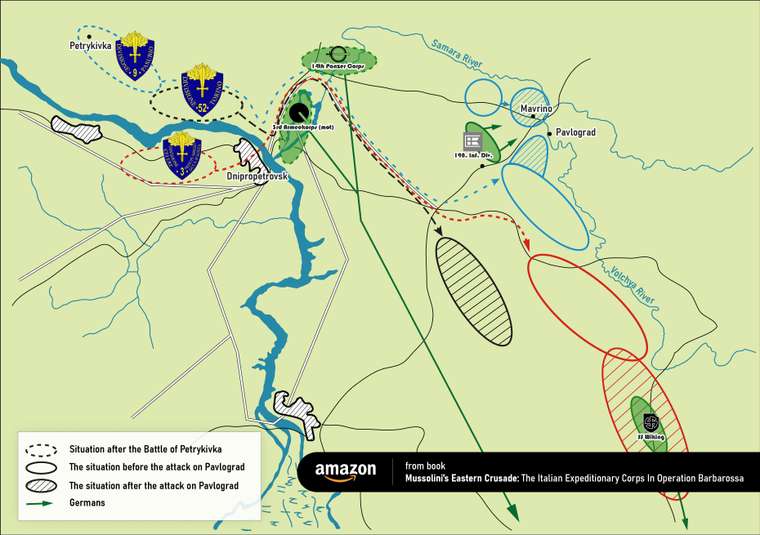
- The participation of Corpo di Spedizione Italiano in the capture of the Donetsk Basin.

- Operation of the seizure of Gorlovka and Rykove by Corpo di Spedizione Italiano.

- Italian offensive in the Tchasepetivka area.
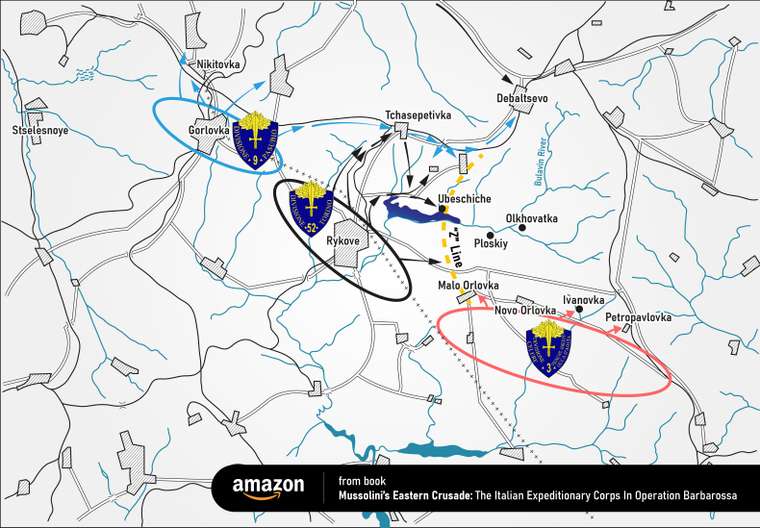
- Christmas Battle (December 25-27, 1941).
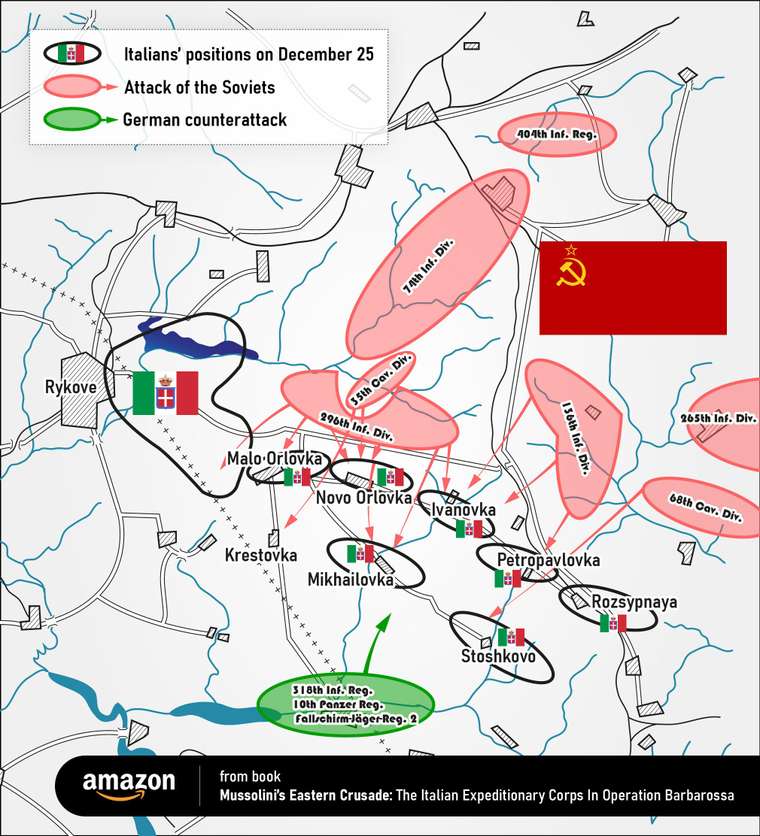
Cover:
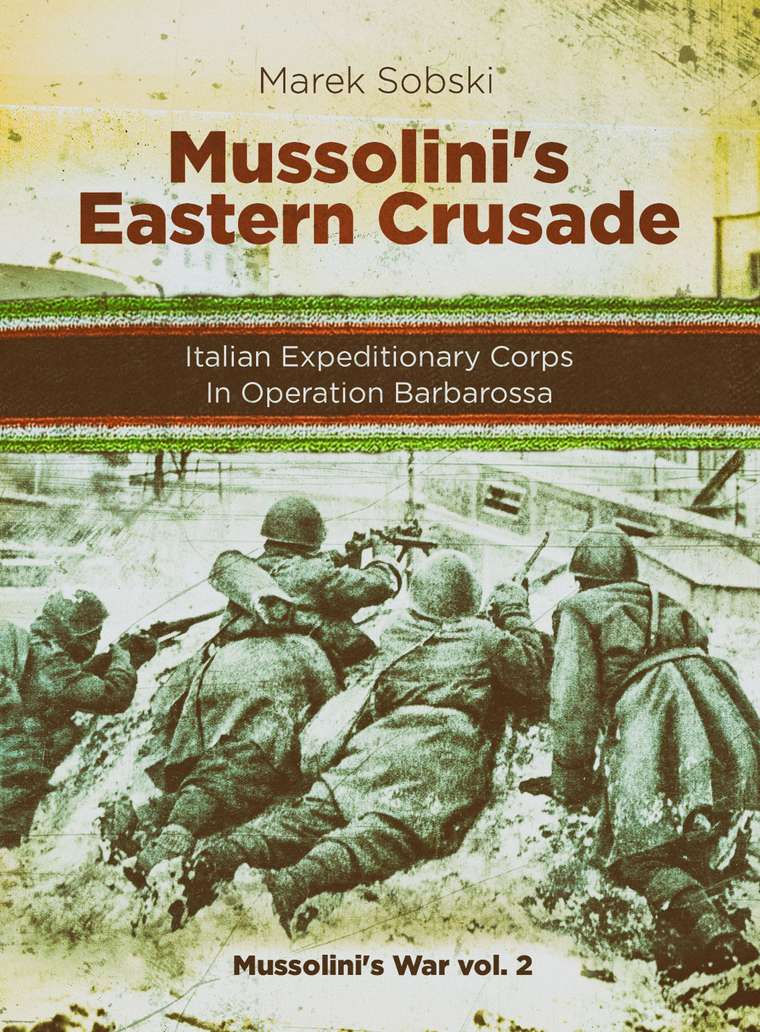

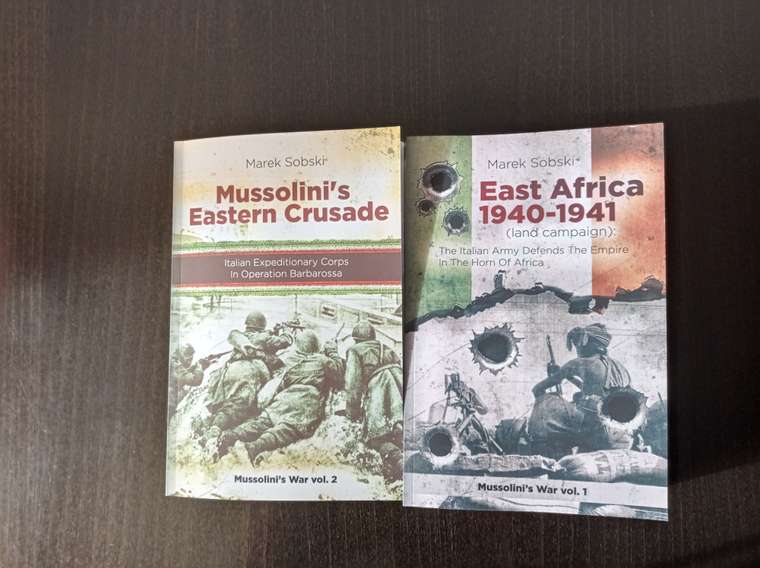
Next goal: France 1940 (land campaign)
Regards,
Marek Sobski
:dark_sunglasses:
-
I’m sorry I won’t buy it, but it looks awesome!
The CSIR was always very interesting to me, because of how detailed the order of battle is in Wikipedia.
-
Hi,
New release!
https://www.amazon.com/dp/B09ZV5QS3P
Next one (vol. 4): Betasom: Italian Submarines in the Atlantic 1940-1945 - scheduled for release in 2023!
The favourite weapon of Benito Mussolini was a bluff calculated for the intimidation of adversaries to force them to yield according to his will. This game of appearances the Italian dictator also practised in the military field. In order not to remain groundless, in 1936, General Alberto Pariani became the Secretary of the State in the Ministry of the War, and Mussolini managed the Ministry personally, and liked to stress the strength of the Italian Army in his cocky speeches, which, if necessary - according to him - would be able to deploy sixty fully equipped divisions. Reality, however, was very different, as for sixty whole divisions there was not enough weapons or even the appropriate number of officers. Thus, Pariani suggested that every infantry division will be reduced from three to two infantry regiments and in this wonderful way the Duce was still able to put a good face to bad game and claim that he had a large and well armed army.
The time of checking this view in a clash with reality, however, was approaching inexorably. On 1 September 1939, Adolf Hitler’s troops attacked Poland, on 3 September, the Allies, Britain and France, supported her by declaring war on the Third Reich. A series of small conflicts and political tensions in Asia, Africa and Europe finally led to the outbreak of another war on a global scale. The Italian dictator, associated with Hitler by the Steel Pact, announced Italy as a “non-belligerent”. Being aware that the country and the armed forces were exhausted by the costs of wars in Ethiopia, Spain and the invasion on Albania, he waited. He compared himself to a cat prowling for a mouse, as he must have had practically mathematical certainty that his attack would succeed and he would not be left with nothing.
The French armed forces in the interwar period had the reputation of the most powerful in the world, additionally protected by the widely-publicised Maginot Line. Moreover supported by Britain and her population and the economic potential of His Majesty’s Empire, they seemed unbeatable. Therefore, it was a surprise to the world when German armoured divisions broke through the forests of the Ardennes and threatened the rear of the Anglo-French troops trying to rescue the Low Countries. After Sedan and Dunkirk, the Duce came to the conclusion that the time for his decisive leap had just arrived, after which his victim would accept any of his conditions.
On 10 June 1940, Benito Mussolini, while speaking to the nation, stated that Italy was in a state of war with the western democracies. Completely unprepared for war, the Italian Royal Army, in the dictator’s intention, had to perform one serious effort so that he could then, as a victor, sit at the peace negotiations table and impose his will on the world. Italian soldiers, despite the collapse of the weather in the Western Alps, were thrown into a frontal attack on the Maginot Line. The Duce calmly calculated that a few thousand corpses would be a small price for a success that he would achieve. The Germans, whenever they undertook frontal assaults on French fortifications, were slaughtered. Could the Italians possibly fare any better?
The book is being illustrated by 8 maps and 94 photographs of the main theme of the work as well as photo album: Blitzkrieg in the Western Europe as seen in the Italian press at the time.
List of chapters:
I. Political Relations of Italy and France in the Interwar Period
II. Time For The Final Decisions
III. The Maginot Line in the Alps
IV. Opposing Forces
V. The First Fighting
VI. Operation “B” - The Battle for the Small Saint Bernard Pass
VII. Advance In the Direction of the Town of Modane
VIII. Briançon: Italian Attack On The Town-Fortress
IX. Advance Of The 1st Italian Army In The Alps
X. Battle of Menton
XI. The Armistice
XII. The Situation On The Border Of Italian And French Possessions In North AfricaRegards!
-
Hi,
New release!
Betasom: Italian Submarines In The Battle Of The Atlantic 1940-1945
Translation: Tomek Basarabowicz (as in previous volumes)
This book describes the operations of a group of Italian submarines that took part in the Atlantic conflict during the World War Two. A total of 32 submarines flying the tricolour flag of the Regia Marina passed through the Betasom base, located at the French port of Bordeaux. Almost two hundred of their combat patrols are presented in detail, all victories and defeats being discussed. The work also covers the story of the base itself, the doctrine of Italian submarines, biographies of commanders, submarines and other factors influencing successes and failures. The Italians commenced their operations in the Atlantic badly, due to a lack of previous experience they turned out to be unprepared for the actions that awaited them, but with stubbornness and hard work, they managed to transform their Atlantic contingent into a very effective fighting machine. Thanks in large part due to the efforts of Betasom’s personnel, the Italian Navy can be proud of being the sixth most effective submarine fleet in the history of this type of weapon. A separate chapter presents the history of the Italian blockade runners, which, based in Bordeaux, were to break into the Far East, carrying in both directions material of strategic importance, urgently needed for the war-fighting of Italy, Germany and Japan.
The book is illustrated with 100 photos or drawings and 15 maps.
List of chapters:
I. Betasom Is Formed
II. Doctrine, Ships And Commanders
III. Road To Bordeaux
IV. The First Patrols From The Betasom Base
V. Hard Winter In The North Atlantic
VI. In The Waters Between The Azores And Gibraltar
VII. The Turn Of 1941/1942 In The South Atlantic
VIII. In American Waters
IX. Twilight Of The Gods
X. Italians In The Far East
XI. Bordeaux As Base For Italian Blockade RunnersNext goal: The struggle and bitter end of the Italian Army in Russia 1942-1943, scheduled for release in 2023!
Greetings!
-
Cool!
-
Hello!
I am happy to announce that the next volume of the Mussolini’s War series has been officially released! (Translated by Tomek Basarabowicz)
At the moment they are available on Amazon Paperback and Hardcover. Kindle eBook will join next week at the latest.
In the previous study ‘Mussolini’s Eastern Crusade: The Italian Expeditionary Corps In Operation Barbarossa’ we recounted the story of the Italian Corps (CSIR) on the Eastern Front until the end of winter 1942. This work continues the story of Mussolini’s soldiers taking part in the campaign that fascist propaganda presented as an anti-Bolshevik crusade. Since the summer of 1942, an entire army sent from Italy (Armata Italiana in Russia, ARMIR), numbering well over two hundred thousand men, had been fighting in the USSR alongside the Wehrmacht.
The next summer offensive of the Wehrmacht in the USSR targeted the oil-rich areas of the Caucasus and, with its success, the industrial city on the Volga River - Stalingrad. The role of the Third Reich’s allies on the Eastern Front was to secure the flanks of this manoeuvre. The ARMIR took part in the initial phases of Operation Blau, and then, acting as a buffer between the incompatible Hungarians and Romanians, took up positions on the River Don. Already by the summer of 1942, the Italians became the target of a Soviet operation aimed at cutting German supply lines and drawing reserves away from the Stalingrad area. The ARMIR passed this first test successfully, taking control of the situation without the help of other Axis forces.
In the winter of 1942/1943, the Red Army carried out a powerful counter-offensive, which in the first stage trapped Paulus’s 6th Army in the Stalingrad cauldron. However, the Soviet reserves seemed inexhaustible, while the German-Romanian attempt to unblock the cauldron was still ongoing the Soviets were already undertaking further operations. Operation ‘Little Saturn’ was to break through the positions of the Italian 8th Army (ARMIR) and threaten the airfields from which Stalingrad was supplied. After its end, the elite Italian Alpine Corps found itself in the middle of another Soviet offensive – the Ostrogozhsk-Rossoshan Operation.
This study presents the story of the desperate battles of the Italian troops during the aforementioned events, including the operations of the air contingent. A detailed description of the battles and many accounts on the heroism of ordinary troops will allow the reader to properly assess the exploits of the Italian soldier on the Eastern Front, which has often been presented in an extremely unfair way. It also touches on such topics as the political and economic goals of the Italian presence in the East and the problem of securing the frontline zone, and the relations of the Italians with the local population.

-
Nice!
Out of curiosity, does this book explain why the Italian Alpine Corps wasn’t sent to fight in the Caucasus Mountains, where they seem to have been better suited? Thank you!
-
Of course! Extensive quotation:
"The rail transports carrying the Alpine Corps began to leave Italy on 14 July 1942. It took the Alpini an entire month to reach the front line. The Corps was to concentrate in Taganrog, a port city on the Sea of Azov. From there, it was to operate in the Caucasus direction.
The scattering of the Italian corps met with opposition from the ARMIR command and resulted in the intervention of General Gariboldi. As a result, it was agreed that the Italian Army in the East would operate as an entity, which in consequence meant that an elite unit such as the Alpine Corps would fight on the steppe instead of in the Caucasus. On 18 August, the Alpini received an order to march to the Don River. This was received with mixed feelings among the Alpine riflemen, and was even considered a disgrace. It was understood that the Corps’ use in open terrain would be a completely new situation for its soldiers, one that had not been predicted during the training process. There was a lack of anti-tank weapons, and only 45 mm mortars were available. The Corps’ light wireless sets had a short range and were completely unsuitable for communication in open terrain (the Corps HQ coordinated the march of its scattered divisions to the Don by sending vehicles with couriers in pairs). Willy-nilly, the Alpini, equipped for fighting in the mountains, marched to the Don along with columns of mules carrying their howitzers."
Greetings!
-
Thank you so much!






